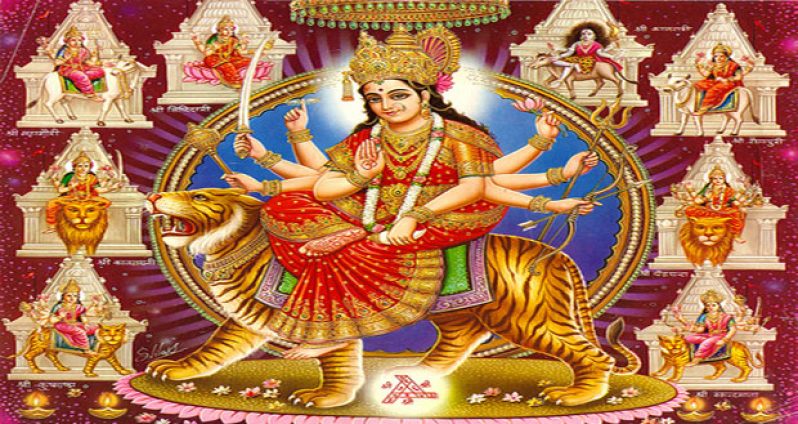CHRISTIANS the world over and most people around the world celebrated New Year’s Day on January 1, but other major world religions also celebrate the significant occasion, but on different dates.On the Gregorian calendar, the Islamic New Year for 2015 will fall on October 15. For Hindus, it was Friday. The occasion was called Chaitra or Vasanta Navratri and it marks year 2072 in the Hindu calendar.
It also marks the beginning of the spring season. Navratri Shakti is a Sanskrit word when translated to English means nine nights and during the festival, Hindus worship the three main manifestations of Goddess Shakti: Durga, Saraswati and Lakshmi, along with her nine forms.
According to Pandit Ubraj Narine of the Guyana Pandit Council, these nine days are divided into three parts of three days each for the three parts of the body – the region below the navel, between navel and shoulders and the upper head region, corresponding to the energies of goddess Sarawati, goddess Lakshmi and goddess Durga respectively.
These three parts are further divided into three parts each, thus the body is divided into nine parts in all, he said.
Her worship is as important in Hinduism as Lord Shiva and Vishnu. Each night of Navratri is devoted to the worship of different deities and the performing of elaborate rituals.
On the first day, homage is paid to the divine mother in the form of Shailputri, the daughter of the Himalayas. She is a form of Shakti (energy), the companion of Lord Shiva; the second day is dedicated to the worship of Brahmacharini, the personification of love, knowledge and wisdom; the third day to the goddess Chandraghanta, the symbolic representation of beauty and bravery; the fourth day to Kushmandas, the creator of the entire Universe; the fifth day to the Goddess Skand Mata, the mother of the chief warrior of the Gods army, the Skanda; the sixth day to Katyayani, the warrior against evil and deceitfulness; the seventh day to Kalratri for bravery; the eight day to Maha Gauri for calmness and wisdom; and the ninth day to Siddhidatri, the treasure house of mystic powers.
Pandit Narine said there are many stories behind the important occasion but told of two of them.
King Dooshibago
The first is of King Dooshibago, who was killed by a lion when he went out hunting. Following his death, preparations were made to crown his son, Prince Sudarsana.
But there was objection. King Yudhajit of Ujjain, the father of Queen Lilavati, and King Virasena of Kalinga, the father of Queen Manorama, each wanted the Kosala throne for their respective grandsons.
Their disagreement led to battle and King Virasena was killed. Manorama, according to legend, fled to the forest with Prince Sudarsana and a eunuch, and while there, they took refuge in the hermitage of Rishi Bharadwaja.
The victorious King Yudhajit crowned his grandson, Satrujit, at Ayodhya, the then capital of Kosala. He then went out in search of Manorama and her son, but the sage advised him not to give up those who had sought his protection.
King Yudhajit became furious and wanted to attack Rishi, but his minister affirmed the truth of the Rishi’s statement and he returned to his capital.
When he got there, fortune smiled on Prince Sudarsana: a hermit’s son came and called the eunuch by his Sanskrit name Kleeba.
The prince caught the first syllable Kli and began to pronounce it as Kleem. This syllable happened to be a powerful, sacred Mantra. It is the Bija Akshara (root syllable) of the Divine Mother.
Peace of Mind
The Prince obtained peace of mind and the Grace of the Divine Mother by the repeated utterance of this syllable. A version of the story found on Wikipedia says the Devine Mother Devi appeared to him, blessed him and granted him divine weapons and an inexhaustible quiver.
Prince Sudarsana, with his wife and his father-in-law, praised the Devine Mother, who in turn ordered them to worship her with havan and other means during the Vasanta Navratri.
Sudarsana’s descendants Sri Rama and Lakshmana also performed worship of Mother Devi during the Sharad Navarathri and were blessed with Her assistance in the recovery of Sita.
According to the Krittibas Ramayana, Rama invoked the goddess Durga in his epic battle against Ravana. Although Goddess Durga was traditionally worshipped in the late spring, due to contingencies of battle, Lord Rama had to invoke her in the autumn.
The New Year is marked by Hindus going to temple, participating in the chanting of sacred hymns and performing pujas to the Divine Mother.
Pandit Narine, who is also a member of the Guyana Sanatan Dharmic Maha Sabha, said during the occasion, the Devine Mother is worshipped for both material and spiritual wealth.
He urged Hindus to embrace each other and all non-Hindus. The occasion, he said, also recognises women and their role in society, pointing out that men would be unable to perform their duties without the help of women.
Women, he said, is the representation of motherhood, and mother is the exemplification of love, kindness and togetherness. As Hindus celebrate the New Year, Pandit Narine urged that they embrace togetherness and the sacred tenets of Hinduism, and work for a brighter future for all Guyanese.
Sharad Navratri, the most important of the Navratris, which is also called Maha Navratri (the Great Navratri), is celebrated at the beginning of winter. It would be celebrated during October 13-22. A belated happy New Year to the Hindu community!
By Tajeram Mohabir




.png)









